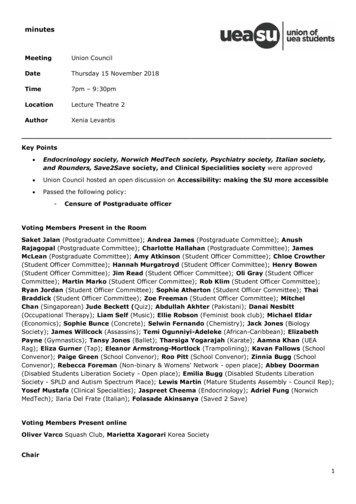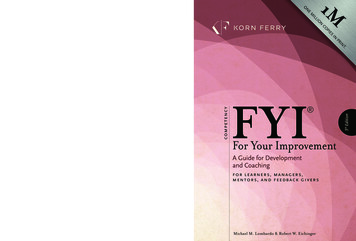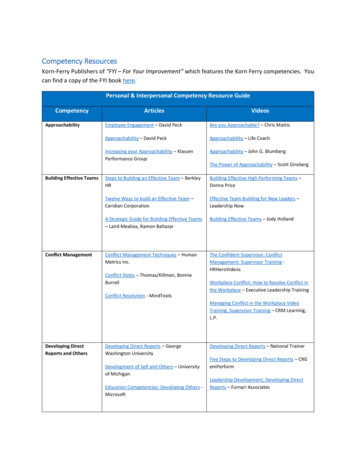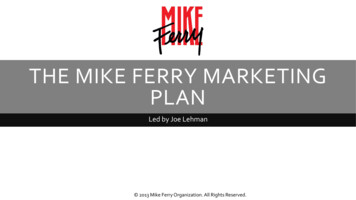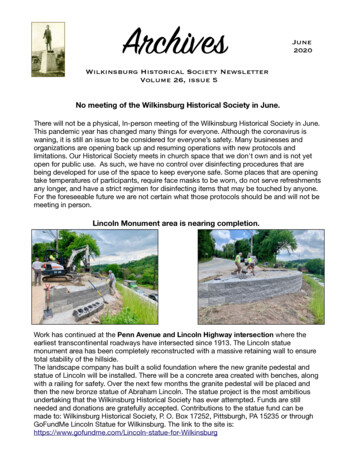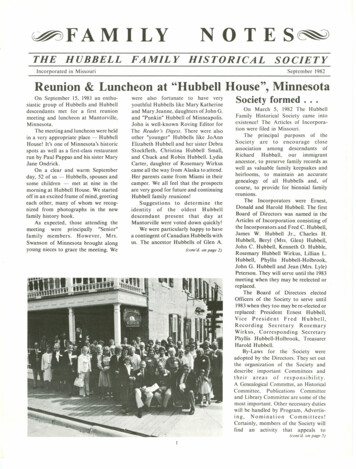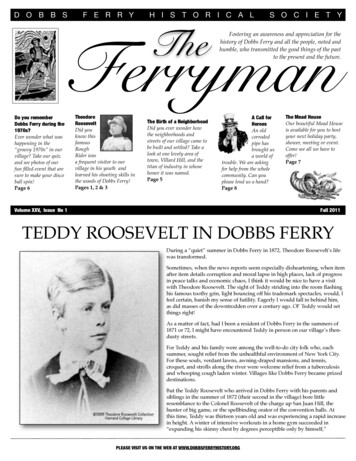
Transcription
D O B B SF E R R YH I S T O R I C A LTheS O C I E T YFerrymanDo you rememberDobbs Ferry during the1970s?Ever wonder what washappening in the“groovy 1970s” in ourvillage? Take our quizand see photos of ourfun filled event that aresure to make your discoball spin!Page 6TheodoreRooseveltDid youknow thisfamousRoughRider wasa frequent visitor to ourvillage in his youth andlearned his shooting skills inthe woods of Dobbs Ferry!Pages 1, 2 & 3The Birth of a NeighborhoodDid you ever wonder howthe neighborhoods andstreets of our village came tobe built and settled? Take alook at one lovely area oftown, Villard Hill, and thetitan of industry in whosehonor it was named.Page 5Fostering an awareness and appreciation for thehistory of Dobbs Ferry and all the people, noted andhumble, who transmitted the good things of the pastto the present and the future.A Call forHeroesAn oldcorrodedpipe hasbrought usa world oftrouble. We are askingfor help from the wholecommunity. Can youplease lend us a hand?Page 8Volume XXV, Issue No 1The Mead HouseOur beautiful Mead Houseis available for you to hostyour next holiday party,shower, meeting or event.Come see all we have tooffer!Page 7Fall 2011TEDDY ROOSEVELT IN DOBBS FERRYDuring a “quiet” summer in Dobbs Ferry in 1872, Theodore Roosevelt’s lifewas transformed.Sometimes, when the news reports seem especially disheartening, when itemafter item details corruption and moral lapse in high places, lack of progressin peace talks and economic chaos, I think it would be nice to have a visitwith Theodore Roosevelt. The sight of Teddy striding into the room flashinghis famous toothy grin, light bouncing off his trademark spectacles, would, Ifeel certain, banish my sense of futility. Eagerly I would fall in behind him,as did masses of the downtrodden over a century ago. Ol’ Teddy would setthings right!As a matter of fact, had I been a resident of Dobbs Ferry in the summers of1871 or 72, I might have encountered Teddy in person on our village’s thendusty streets.For Teddy and his family were among the well-to-do city folk who, eachsummer, sought relief from the unhealthful environment of New York City.For these souls, verdant lawns, awning-draped mansions, and tennis,croquet, and strolls along the river were welcome relief from a tuberculosisand whooping cough laden winter. Villages like Dobbs Ferry became prizeddestinations.But the Teddy Roosevelt who arrived in Dobbs Ferry with his parents andsiblings in the summer of 1872 (their second in the village) bore littleresemblance to the Colonel Roosevelt of the charge up San Juan Hill, thehunter of big game, or the spellbinding orator of the convention halls. Atthis time, Teddy was thirteen years old and was experiencing a rapid increasein height. A winter of intensive workouts in a home gym succeeded in“expanding his skinny chest by degrees perceptible only by himself,”PLEASE VISIT US ON THE WEB AT WWW.DOBBSFERRYHISTORY.ORG
THEFERRYMANTeddy (left) with his cousins in the winter of 1873 following his summer in Dobbs Ferry, and shortly before college (below).Teedie, Elliot, Cousin Maude Elliot, Corinne, and CousinJohn Elliot !!Dresden 1873according to Edmund Morris (one of hisbiographers).Morris further describes the teenage Teddy as“a grotesque flower of adolescence, offensiveto eye, ear, and nostril.” (Obsessed withtaxidermy, Teddy often reeked of noxiouschemicals.) Morris continues: “Snarling teeth,overlong hair (childish yellow darkening todirty blond; bony wrists and ankles, whichprotruded every day a little further from hiscarefully tailored suit. His voice withundertones of harshness, yet shrill in theupper registers.” 1And then there was Teddy’s asthma. It’s notcertain when the attacks began, although mostaccounts give the date as around 1862, whenTeddy (called “Teedie” by his family) wasfour years old. He would wake up in a panic,yowling and gasping for breath. Hisfrightened parents would rush to and fro,desperately searching for any means ofrelieving the child’s agonized struggle. Overtime, as Teddy’s attacks continued to recur,the family developed means of coping. Atransfer to the fresh air or even a hurriedcarriage ride to the seashore would suffice inmany cases. When all else failed, giving thechild a cup of strong black coffee or havinghim smoke a cigar would do the trick.Little was understood regarding asthma inthe mid-nineteenth century. DavidMcCullough, one of Teddy’s biographers, hastheorized that Teddy’s affliction wassomehow connected to the turmoil his familyexperienced during the Civil War. WhileTeddy’s father was a staunch Unionist, hismother was from the south – Georgia, to beexact. Margaret Roosevelt’s family wasplanter aristocracy. Her brothers and otherrelatives all served in the Confederate army.Teddy’s father, fearful of the effect upon hisdelicate wife that going into battle against herbrothers might have, hired a substitute to takehis place in the army.2Given the extent of their maladies, it wouldseem that a couple of months along theHudson would offer little relief. However, itwas during this time in Dobbs Ferry thatTeddy’s life, at least, began to turn around.The Roosevelts arrived in Dobbs Ferry andsettled in at the large house called “Dungled”owned by the Paton family with a magnificentview of the river. The Patons, according to onesource, were cousins of the Roosevelts.“Dungled” was razed in 1928 and is now thesite of the Masters School’s “Hill Dorms” andCity Term School, reached by a left turn offClinton Avenue at the far eastern end of thecampus.However, this seemed to create severe stressfor Theodore Sr., a philanthropist. He threwhimself into the launching of a programwhich would enable Union soldiers to sendmoney home. This required great effort onhis part, visiting far-flung camps and talkingwith groups of soldiers. (Evidently, sendingpart of their paycheck home to desperatewives and children was a novel idea to manyUnion soldiers.) As a result, Teddy’s fatherwas away from home for long periodsduring Teddy’s early years.Another theory, also mentioned byMcCullough, involves a possible fear ofchurch on Teddy’s part. He had, as a smallchild, been frightened by a verse of scripture.(John 2:17) “And his disciples rememberedthat it was written, the zeal of thine househath eaten me up.” Little Teddy thought thezeal lurked in a dark corner of the church,waiting for him, or so he confided to hismother. The fact that most of his attacksoccurred Saturday night or Sunday morningmay lend some credence to this theory.In addition to Teddy’s affliction, his siblingshad their own health issues. His sister Annasuffered from Potts Disease, a form oftuberculosis which destroys bone tissue. InAnna’s case, it was concentrated in the spine,resulting in hunchback and constant pain.Brother Elliot, in addition to severe headachesand insomnia, was given to strange seizures,accompanied by a rush of blood to the headand even delirium. His other sister Corinnealso suffered from asthma.Hill Dorms. The "Hill Dorms" of theMasters School is now located where thePaton residence, "Dungled" once existed.headaches and intestinal grief. She was givenether treatments for the somewhat vaguemaladies.Overseeing this beleaguered brood wasTeddy’s mother, a woman of fragile naturewho suffered from heart palpitations,Teedie, Corinne, Edith and ElliotOysterBay 1876In the city, Teddy had become obsessed withtaxidermy, so he began collecting mice andother small rodents which he kept in one ofthe bathtubs.Theodore Sr., observing Teddy’s activity,made a momentous decision: he presentedTeddy with his first gun.This firearm, a rather simple double-barreledshotgun of French manufacture andconsidered quite suitable for a beginner, madeTeddy ecstatic. Now he could go after biggergame for his taxidermy projects.Eagerly, he joined his brother and friends inthe woods around Dobbs Ferry; but with noresults!THE MEAD HOUSE 12 ELM STREET DOBBS FERRY, NEW YORK 10522
THEFERRYMANUnited States and ultimately to hismassive and successful efforts to preservethe wilderness. The spectacles along withhis grin would make him famous aroundthe world and become symbolic of theprogressive movement in politics.Also, it should be noted that his asthmaattacks began to decline around this timeand would virtually disappear as he lefthome for college.Remnant of the carriage way leading fromthe pond to the Paton mansion. TheRoosevelts would have traveled this road.No matter how often he fired away, hecould hit nothing. Disconsolately, hewatched the other boys take his gun and,according to his memoirs, “bag theinvisible.” The final blow came when theboys read aloud huge letters on a distantsign. Teddy could not even see the letters!Today, 139 years after Teddy’s stay inDobbs Ferry, it is difficult to findreminders of the Roosevelts’ time here.All that remains of the old Paton house isa circular driveway at the east end of thehill dorms building at The MastersSchool.It was then that Teddy’s father made hissecond momentous decision: he tookTeddy to an eye doctor, who fitted himout with his first pair of spectacles. ThusTeddy’s life was transformed as a newworld opened up to him. In the words ofEdmund Morris, another biographer:“Through the miraculous little windowsthat now gripped his nose, the worldleaped into pristine focus, disclosing aninfinity of detail, of color, of nuance, andof movement just when the screen of hismind was at its most receptive.”2This plaque, attached to a pew in the SouthPresbyterian Church, marks the placeoccupied by the Roosevelts on Sundaysduring the summer of 1871.If you follow Estherwood Avenue fromthe intersection to its end, you will cometo what was once Paton Pond. Now anarea of marsh grass and no pond, it was afavorite gathering place for children inthe Victorian era. Most certainly, Teddyand his siblings would have enjoyedswimming, fishing, and sailing theirmodel boats there.At the South Presbyterian Church, aplaque marks the pew where theRoosevelts sat during church services.One other reminder, however, cansometimes be spied peering from thecorners of baby carriages or shopwindows: the teddy bear.Edmund Morris. The Rise of Theodore Roosevelt. New York,Coward, McCann, and Geoghegan, Inc. 1979.Thus, at Dobbs Ferry was born thequintessential “TR.” The present of ahunting rifle led to a hunting trip inAfrica, South America, the westernON THE WEB AT WWW.DOBBSFERRYHISTORY.ORGDavid McCullough. Mornings on Horseback, New York.Simon and Schuster, 1981.Paton Pond. Located at the very end ofEstherwood Avenue, where the streetbecomes a path, this spot was a favoritegathering place for village youth in the19th century. Teddy Roosevelt wouldcertainly have enjoyed fishing, swimming,sailing model boats, and collecting frogsand mice in the pond. After the purchase ofthe property by the Masters School, thepond became an aquatic treasure house forgenerations of Masters science teachersand their pupils. In the early 1970s, afterrecurring incidents of flooding in nearbyhomes, Masters drained the pond, leavingonly this marshy area of tall grass.Bordering this site is a path which is aremnant of the carriage way up the hill tothe Patons'. (Clinton Avenue did notextend this far).Paul Grondahl. I Rose Like a Rocket. New York, Free Press2004.Theodore Roosevelt. Theodore Roosevelt’s Diaries of Boyhoodand Youth. New York, Charles Scribner’s Sons, 1928.Carleton Putnam, Theodore Roosevelt: Volume I TheFormative Years 1858 – 1886. New York, Charles Scribner’sSons, 1958.Archives. Dobbs Ferry Historical SocietyFootnotes1Morris, The Rise of Theodore Roosevelt p. 61.2Ibid p.52.WRITTEN BY LARRY BLIZARD3
THEFERRYMANMEET SOME YOUNG HEROES : OUR VOLUNTEERSTHIS YEAR’S INTERNSJoanne Mumbeyand MorganWright are picturedhere in front of TheSeventies Timelinethat theydeveloped tohighlightmemorablehistorical eventsand images fromthat crucialdecade.ChristopherDonoghue infront of one ofthe newlyrenovatedstaircases in theMead Housegarden.SCOUT RENOVATES THE STAIRCASE!Joanne Mumbey and Morgan Wright, Dobbs Ferry HighSchool Seniors, put their talents to work as interns for theHistorical Society this spring. As a part of the end-of-schoolinternship program, the young women spent three weeks workingat the Mead House on a variety of tasks.!Using their computer skills to good advantage, theyscanned many of our historical photographs into the computer,adding finding aids for quick retrieval. They organized andcatalogued our extensive map collection and also collectedinformation to answer several questions posed by severalvillagers. They created two display timelines: A Brief History ofDobbs Ferry and The Seventies. On several sunny spring days, theyworked outside--improving the layout of the herb garden andplacing identifying labels by the various herbs.!Visitors to this year’s Road to Freedom Celebration at theMead House were delighted to find new stairs leading to the lowerpart of the garden. The stairs were the result of a year’s work byChristopher Donoghue, a Boy Scout who completely renovated stairsthat had fallen into terrible disrepair because of years of neglect.!Working towards an Eagle Scout award, Christopherdesigned steps with a gentle incline and railings to provide addedsupport for villagers as they stroll through our garden. He and othermembers of Dobbs Ferry Scout Troop 24 cleared away the underbrush,carted away the remnants of the old staircases and installed the newones on two successive weekends. Made of pretreated lumber andgravel inserts for drainage, the stairs are a very useful addition to theMead House garden. They are as beautiful as they are functional.Please stop by to admire them!!Such volunteer assistance is absolutely essential to thetask of preserving and promoting Dobbs Ferry’s history and weare very grateful to these young women for their efforts. We wishthem well in their next academic endeavors, Joanne at a culinaryschool in Rhode Island and Morgan at a Long Island art school.!The Historical Society is grateful to Scoutmaster EdmundDalio, Troop 24 and especially to Christopher Donoghue for thiswonderful project. We send our gratitude and best wishes toChristopher this fall as he begins his first year at Seton HallUniversity.SAVE THEDATE !Sunday, November 6, 2011at 2:00 pmDobbs Ferry Public Library55 Main Street!The Dobbs Ferry HistoricalSociety is pleased to announce that masterraconteur, Jonathan Kruk, will give apresentation in Dobbs Ferry about hisnew book, published by The HistoryPress, Legends and Lore of Sleepy Hollow andthe Hudson Valley. The book will beavailable for sale and signing. It has beenpraised as “a book .with many great4stories perfect for reading aloud to thefamily. And it also includes muchscholarship, which will appeal to studentsof cultural history. Highly recommended!"!Jonathan Kruk was born an armybrat in El Paso, Texas, but grew up here inWestchester on hyperbolic tales. Hisgrandfather, Joseph A. Nowicki, YonkersCity Clerk, often stirred up tediousmeetings with stories he read into theminutes, in Polish. Jonathan took a cuefrom his "Dza Dza" and became a careerprofessional storyteller in 1989. Now, heperforms in area schools, libraries, historicsites and, of course, tells The Legend ofSleepy Hollow every October at the OldDutch Church in Sleepy Hollow.!Jonathan earned a B.A. inEnglish from Holy Cross College inWorcester, MA and got a M.A. ineducational theater at NewYorkUniversity. He launched his career at theDobbs Ferry Library, joining a circle ofstorytellers lead by the late Aggie Griesar.!Returning to Dobbs Ferry onNovember 6th, Mr. Kruk will share secretsources Washington Irving used toestablish the iconic Headless Horseman.He will tell the full stories of severalintriguing ghosts known in the region,including Dobbs Ferry. Look for a shortperformance of a haunted history tale too.Admission is free. See you there !StorytellerJonathanKruk joins usfor anafternoon ofHudson Valleyfolktales.Don’t miss it !THE MEAD HOUSE 12 ELM STREET DOBBS FERRY, NEW YORK 10522
THEFERRYMANVILLARD HILL : BIRTH OFA NEIGHBORHOODWhat we all now know as Villard Hill sits at the highest pointin Dobbs Ferry. It was first owned by two brothers, Samueland Thomas Cochrane. The brothers purchased 100 acres ofland at the top of the hill on Clinton Avenue.Sometime before 1857, two identical houses were built, one foreach brother. The property around the homes was laid out asa private park by Frederick Olmstead. Thomas’s house wascalled Dunedin and Samuel named his home Thorwood.Thorwood was sold to Henry and Fanny Villard in 1879. Anew architectural firm enlarged the home by the addition oftwo wings built onto the house. This was the first commissiondone by McKim, Mead and White.Henry Villard died in 1900 and his wife Fanny died in 1928.In 1930 the property was sold to Joseph Patterson, the ownerof the New York Daily News. He tore down both homes andgave the development the name, ‘Villard Hill.’From the advertisements for Villard Hill:‘delightful homes can be completed on plots with room forample gardens for as little as 15,000’‘houses vary widely in architecture to express owner’s tastes,yet all are planned to harmonize with their surroundings’‘All architecture must be of the Early American, Georgian,Regency or English type.’And still true today:‘commuting from Dobbs Ferry to Grand Central is a matter ofonly 35 minutes.‘!BY MADELINE BYRNEHenry Villard American journalistand early president ofthe Northern PacificRailroad, for whichVillard Hill is named.He completed thetranscontinentalrailroad line. Earlyfinancier of ThomasEdison, he boughtEdison LampCompany & EdisonGeneral andreorganized it intothe General ElectricCompany in 1893. Hedied at his summerhome Thorwood inDobbs Ferry inNovember 1900.ON THE WEB AT WWW.DOBBSFERRYHISTORY.ORG5
THEFERRYMANOUR 70s SHOW WAS A MEMORABLE SUCCESS!Cool 70s clothes, dynamitefood, a hip quiz, folk songs,disco dancing and good fun we had quite a great tripdown memory lane recallingthe 1970s at our event onJune 11th at the Mead House.Check out these photos courtesy of Anne MarieLeone - then have a try at ourquiz.How well do YOU rememberthe 1970s?Remembering how she looked inthe 70s, Sandy Walters added ababy bulge to her outfit.Lilly and Howard Pobiner infull costume disco dance onthe Mead House porch.Anne Schneider, a hip chick with agreat message for all of us.The winner of the 50/50 raffle, Emma Lou Sailors, left,receives the 235 prize from Ellen Klein.Matt Turk leads guests in a singalong of 70s tunes on his guitar.Laura Lynn O’Halloran looking groovy sportsa cool head scarf of the 1970s.DO YOU REMEMBER.1. What happened in New York City on July13,1977?2. What form of transportation first appeared in the 70s? a. Skateboard b. Jumbo Jet c. Ford Edsel d. Space Shuttle3. Who was the only vice president in U.S. history to resign because of criminal charges?4. Who was the lead male star in “One Flew Over the Cuckoo’s Nest”? a. Al Pacino b. Jack Nicholson c. Robert Duval d. Paul Newman5. What momentous event happened throughout the US on April 22, 1970?6. What was the moniker of the informer who supplied information to Bob Woodward in the Watergate conspiracy?7. Abbie Hoffman was : a. The most decorated Vietnam Vet b. Bill Cosby’s comedy writer c. Spiro Agnew’s nemesis d. A US senator8. Who was the longest serving mayor of Dobbs Ferry in the 1970s? a. John Nanna b. William Zemnick c. Philip Melillo d. Rolon Reed9. Mark Spitz won 7 gold medals at the 1972 Olympics located in what city?10. The bar & grill that preceded Double Days on Main Street was called : a. Scappy’s b. the Peanut Room c. The Ferry Inn d. Cherry’s11. In the early 1970s a streaker ran through what local institution?12. Who beat whom in the 1973 tennis match billed as the “Battle of the Sexes”?13. What home entertainment device was invented in the 1970s? a.VCR b. 16mm projector c. DVD player d. ipod14. During the oil crises of 1973 & 1979 despite the shortage, the price of a gallon of gas in 1973 never rose above .?ANSWERS : 1. BLACKOUT 2. B 3. SPIRO AGNEW 4. B 5. THE FIRST EARTH DAY 6. DEEP THROAT 7. C 8. A 9. MUNICH 10. C 11. MASTERS SCHOOL 12. BILLIE JEAN KINGBEAT BOBBY RIGGS 13. A 14. 16THE MEAD HOUSE 12 ELM STREET DOBBS FERRY , NEW YORK 10522
THEFERRYMThe Mead HouseANTHE HEADQUARTERS OF THEDOBBS FERRY HISTORICAL SOCIETY12 ELM STREETDOBBS FERRY, NEW YORK 10522NEED A PLACE TO HOLD AN EVENT?The beautiful Mead House home of the Dobbs Ferry Historical Society isavailable for use for community meetings and private events.Built in 1855 this historic house is handicap accessible, centrally located intown and offers three spacious rooms, a newly refurbished kitchen and lovelygrounds with a turn-of-the-century wraparound porch.Club meeting, rehearsal space, birthday party, baby shower, anniversarycelebration, office holiday party, you name it - the historic Mead House isthe perfect place for your next gathering!Rates:Single time use meetings space - 40Social Event (up to 4 hours) - 250Monthly use - 300 per yearWith so many complimentary amenities available for your use, it’s an easy,affordable place to host your event.PLEASE COME SEE HOW MUCH WE HAVE TO OFFER! Card tables and folding chairsFor more information contact us at(914)-674-1007or visit us on the web atwww.DobbsFerryHistory.org 7- piece china place settings 6- piece silverware settings Large and small automatic coffee urns Punch bowls and punch cups Audio/visual equipment And much more! Contact us for a fulllist of our amenities.7
THEDOBBSFERRYHISTORICALSOCIETYNon-Profit OrganizationU.S. PostagePAIDPermit No. 2215White Plains, NYTHE MEAD HOUSE12 ELM STREETDOBBS FERRY, NEW YORK 10522NEWSLETTER DESIGN: ROBIN COSTELLOCONTACT US BY PHONE : (914)-674-1007EMAIL : DFHISTORY@OPTIMUM.NET. ON THE WEB: WWW.DOBBSFERRYHISTORY.ORGDOBBS FERRY IS IN NEED OF HEROES.This time, to save our house.WEIn August, we remembered and celebrated the patriots and heroes whofought in the war of independence. Today Dobbs Ferry is once more inneed of heroes. This time to save the Mead House, the home and heart ofthe Dobbs Ferry Historical Society.WANTYOU !The situation is desperate.While doing repairs under the house, we discovered the pipe thatbrings gas to the house was rotting. The plumber told us the pipes werenot up to code and would have to be replaced. A Con Edisoninvestigator shut off our gas and told us since we are listed as acommercial enterprise we would have to pay for the replacement costs.The cost: 16,000!That is a sum we do not have. Of course, without gas we have no heat.Without gas we have no hot water. And without gas we will lose ourresident caretaker who helps to maintain our Mead House.We need your help.Without gas we will have to shut down the house and stop all the workand research that the Society does to gather our village’s history thatadds to the prominence and pride the village enjoys.If you have been to the Mead House lately you know that it’s in the bestshape ever. Many have helped financially, others with their volunteerlabor to restore the House to its original beauty. It would be a shame tolose it all now. We need you and all members of our community to stepup and help us save our home.Please renew your membership now. If you are not yet amember, join us now. Our Hero’s annual membership fee is 50. At thesame time we hope you will contribute an additional amount to help ussolve our desperate problem. Give as much as you can. 50 will be great. 100 would be stupendous. More would be more than heroic.The Dobbs Ferry Historical Society is a valuable asset to our village. It is therepository of records, photos, maps, oral histories and much more coveringour earliest days from the 18th century to today. It is open and used byscholars, educators, school children, anyone interested in our rich history.The Mead House is essential to our work and mission. Don’t let it close.Be a hero.Please fill out the coupon and send us your contribution.Of course, all contributions are tax deductible.Dobbs Ferry needs you!Please do it now.Yes, I want to preserve the Mead House, the repository of the richhistory of Dobbs Ferry from the beginning of our republic to thepresent, for the following amount:!( ) My Hero membership dues of 50.!( ) And an additional amount of .!!( ) Please alert me to how we’re doing in our effort tosave our home. My email address isName:Address:Please send your contribution to us at:DF HISTORICAL SOCIETY at MEAD HOUSE12 ELM STREET DOBBS FERRY, NY 10522Or visit us at : WWW.DOBBSFERRYHISTORY.ORG
1 Morris, The Rise of Theodore Roosevelt p. 61. 2 Ibid p.52. WRITTEN BY LARRY BLIZARD Paton Pond. Located at the very end of Estherwood Avenue, where the street becomes a path, this spot was a favorite gathering place for village youth in the 19th century. Teddy Roosevel
